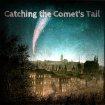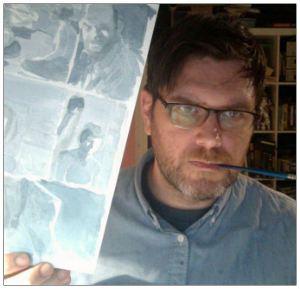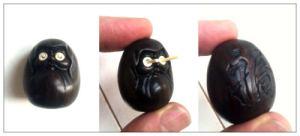 This week’s Catching the Comet’s Tail features graphic novelist Glyn Dillon. His book, The Nao of Brown, tells the darkly beautiful story of Nao, a half-Japanese woman who falls in love with a washing machine repairman. Dillon’s illustrations are stylistically diverse and sublimely coloured, making Nao one of the most exquisite tomes I have on my bookshelf. Earlier this year, Glyn was awarded the Prix Spécial du Jury at this year’s comic book equivalent of the Oscars, the Angoulême International Festival Of Bande Dessinée. I was curious to discover whether Glyn’s creative process differs whether he is writing or drawing. Here’s what he had to say…
This week’s Catching the Comet’s Tail features graphic novelist Glyn Dillon. His book, The Nao of Brown, tells the darkly beautiful story of Nao, a half-Japanese woman who falls in love with a washing machine repairman. Dillon’s illustrations are stylistically diverse and sublimely coloured, making Nao one of the most exquisite tomes I have on my bookshelf. Earlier this year, Glyn was awarded the Prix Spécial du Jury at this year’s comic book equivalent of the Oscars, the Angoulême International Festival Of Bande Dessinée. I was curious to discover whether Glyn’s creative process differs whether he is writing or drawing. Here’s what he had to say…

“Is creativity within me? Hmm… I’d say there’s something somewhere, I don’t know where, like there’s an ‘ideasphere’ and that’s where all the good stuff is. When you’re tuned in to that, things just flow, both with writing and drawing. So it’s a case of trying to get an ‘Access All Areas’ pass for that. But really that’s only the half of it, because there’s also a lot of cliched crap. I’m the ‘ideasphere’, so once I’ve got whatever it is I want down on paper, I need the editor part of my brain to come in and sort it all out to re-write or re-draw it. Being truly productive for me, is when I’m able to get those two very different ways of working to dance together in time.
And as for a muse? I got lucky, I married mine.”
Was creativity encouraged in you as a child?
“Absolutely. My dad and brother are artists and my mom and sister are both very creative too. My brother was probably the biggest influence though. He was already drawing comics professionally having started aged 16. When I was 17, I met and became friends with Jamie Hewlett (creator of Tank Girl & Gorillaz) who inspired and influenced me in other ways, especially in his work ethic.”
How long did it take to put together The Nao of Brown? Can you recall the first spark of inspiration and is the finished work what you first envisioned?
“The original idea for The Nao of Brown was sparked by my eldest boy. When he was about 18months old, he was scared of our washing machine – not when it was on and whizzing round – but when the door was open. He was scared of that dark hole. That led to the inspiration for Gregory, the washing machine repairman, and in his story, Nao was going to be his love interest. At the time I was learning to meditate, which also coincided with me learning my wife had suffered with OCD as a child and into her late teens. All these things combined over a weird three day period and the major elements of the story fell into place. Nao upgraded herself to being the main protagonist after it became obvious that she should have OCD. I wanted to learn as much as possible about the condition and this seemed as good a way as any.
Those early ideas were bubbling up around 2008 and I finished the book in May 2012. I had to take on storyboarding jobs as well so I wasn’t able to work on Nao full-time until the last seven months when I worked seven days a week, 9.00am to 3.00am, which was pretty tough going.
How did I know the book was finished? Well, I guess when I was high on drugs, in hospital because of my back, but was still going over the wet proofs for the dust jacket… even after I was discharged, I was still being picky about things when I got home. I guess I found it difficult to let go. But I suppose I knew it was really finished when my publisher handed me a fresh copy out of a box that was full of them. That was a great feeling.”
Who, what or where always inspires your creativity and what, if anything, is guaranteed to kill it?
“Travelling is always good for inspiration because suddenly all the usual things, the everyday, commonplace things are a little different (or very different depending on where you are). I find this visually exciting and inspiring, the senses feel that bit more heightened. Also, architecture inspires me – having a new sense of place sparks my imagination.
In terms of writing, I find solitude a necessity. Ideas are elusive, slippery things; you have to listen out for them carefully so you can’t afford to have any other voices in the room. With drawing however, it’s not always the same. Once the layouts have been thumbnailed, it’s possible to listen to the radio or music with lyrics and work at the same time.
I have to be able to create a safe bubble. If outside worries or stresses intrude, it can become impossible to work and those things will need sorting before I can carry on.”
Do you ever feel that creating new things is a chore? What do you do when you feel blocked creatively?
“If I’m creating new things for myself, whether it be a book or a sandcastle with the kids, then no. However, if I’m working on a film and I don’t quite have that ‘taste alignment’ with the director, then yes, sometimes it can feel like a chore and I become fully aware of my ‘gun for hire’ position. I sometimes have to look hard for something in a bad idea that can hold my interest for the duration. But some twisted part of me enjoys that challenge.
I’m not a real believer in writer’s or artist’s block. In my experience, if you’re having a bad day where nothing is flowing, you just have to keep working, even if you know it’s shit. Eventually you’ll turn a corner and it’s all the more satisfying knowing that you’ve worked your way through it. Maybe what people are talking about when they say ‘writer’s block’ is either fear, or even depression – but that’s obviously a different thing entirely.”
Is there a collaborative element to your work?
“Storyboarding film and commercials have paid the mortgage over the last seventeen years, and that’s quite a collaborative process. What I enjoy most about it is that my job isn’t the end product, it’s just part of the process. Once used, it’s disposable; only a handful of people get to see it. This is a very good exercise for the artist’s ego. It freed me up a lot, so when I came back to comics, to doing Nao, I think I was much freer than I had been in the past with regards to my work.”
Please talk a bit about the environment you like to be in to write.

Glynn’s ‘messy’ desk
“We’d just had our attic converted when I started on Nao, so that became my workspace. When writing, I shifted my days around so that I was working through the night and sleeping in the day. I wrote the whole book before I started drawing. I wrote it in a film script format, with no page breaks, and went through six drafts before I felt I could start thumbnailing. It took three months of nights to get through those six drafts. I saw more of the kids during the week because I would wake up around 4pm and not start work until they’d gone to bed. This was great, except weekends were hard on my wife because I was sleeping in the day. I consider myself very lucky in that department; my wife and family were completely understanding and supportive of me. I know it wasn’t always easy on them, so I’m very grateful. So, getting back to the question, my ‘environment’ was, and is, my family. And when that relationship is good and supportive, it makes the work so much easier.
When writing I only listen to wordless things – lots of soundtracks or foreign language stuff – 60s Bollywood soundtracks are a particular favorite. In the early stages of note taking and gathering ideas for Nao, I listened to a lot of music that I thought Nao would like. A lot of this was stuff I wouldn’t listen to myself, but it really helped with the building of her character.”
Did you have a daily routine when you were writing/drawing Nao?
“After the writing stage of Nao was over, I returned to daytimes and stuck quite rigidly to working 9.30-6.30, six days a week, and then sometimes I’d work in the evenings as well. I always tried to get out of the house to eat lunch and read the paper. Otherwise those four walls would quickly become oppressive. Luckily, my ‘commute’ was only upstairs so if I felt the need to see some smiling little faces, it wasn’t far to go.
I’m definitely more of a night person, always have been, but having small children isn’t conducive to that lifestyle. Once they’re teenagers I’m sure I’ll edge back more towards what feels like my natural state.”
Please share a photo of an object that connects with your creative process and tell us about it.

“This is something my wife gave me and I can still remember the shock felt by both me and my eldest son when I first opened it. I tipped it slightly and his eyes popped out! It made us both really jump. It’s a Daruma Netsuke [miniature Japanese sculpture] and Daruma is a direct inspiration for Gregory [the washing machine repairman in Nao].”
Which other creative art form outside the one you are known for do you wish you could master or have you mastered another that we don’t know about yet?
“It would be nice to play a musical instrument but I never seem to find the time. And I’ve always fancied the idea of a bit of topiary in my retirement years (if they ever come).”
How did becoming a parent affect your creativity?
“I think it’s safe to say it made me work harder. I was nervous because our second son was due at the same time I was due to start on the book. I had no idea how that was gonna work out. The saying that goes, “It’s never the right time to have a child,” could just as easily apply to writing a book. You just have to get on with it and deal with things as they come up.”
Please say as much or as little as you’d like about your next creative project.
“At the moment I’m working on a film, as a concept artist in the costume dept. I’m also at the fun stage of a new book project. Trying to remain alert and aware of everything going on around me that might become a part of the book. So far I have a setting, a protagonist, a theme. I think I’m going to try a more improvisational approach with this one, I just need to get hold of that ‘Access All Areas’ pass.”

Next week’s Catching the Comet’s Tail features musician KT Tunstall talking about her creative process.
